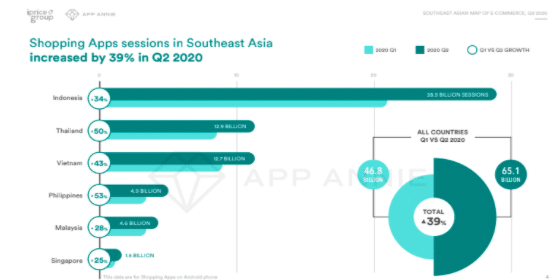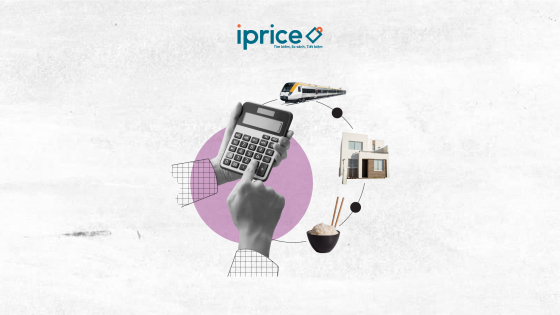Co-author, Ta Nguyen Huong
By now it’s safe to say COVID-19 has been the strongest force pushing for digitalization in retail that we’ve seen in a long time. Within weeks, everything suddenly moved online. iPrice Group and App Annie reported back in September that usage of Android shopping apps in ASEAN grew by 39% within 3 months. Vietnam, Thailand, and the Philippines saw growth of up to 55%.
Efforts of eCommerce companies to advocate for online shopping in Southeast Asia paid off overnight.
What’s next then? Now that ASEAN consumers have installed their shopping apps, and opened their digital accounts, where is the market heading towards and what exciting developments can we expect from ASEAN eCommerce in 2021 and beyond?
Here are my 3 data-driven predictions for the future of ASEAN eCommerce.
The era of B2B
Southeast Asia has been the playground of B2C eCommerce giants for a while, but starting from 2020, it is looking more and more like a dreamland for B2B and B2B2C eCommerce as well.
Amid social distancing measurements, suppliers have moved their sales operations online and rapidly redefined their supply chains and fulfilment. On the other hand, B2B buyers, especially the mom-and-pop shop owners, who account for 70-85% of the FMCG retail market in Indonesia, the Philippines, and Vietnam, suddenly became much more comfortable with utilizing technology.
These factors combined open up a previously closed door for B2B eCommerce in the region. Forrester forecasts that B2B eCommerce in the region will grow at 12.1% per annum, with B2B online marketplaces at the core of changing buyer behavior.
That’s why in 2020, many Southeast Asian B2B eCommerce platforms have sprung up and begun to attract investors.
Telio, which is claimed to be the first Vietnamese B2B eCommerce platform, raised USD $25 million in a Series A round. While in Indonesia, GudangAda secured two consecutive rounds of financing, with a total amount of 30 to 40 million US dollars.
Vietnamese conglomerate Vingroup announced the launch of VinShop offering store owners a digital platform where they can order directly from suppliers and vendors. Zilingo raised a Series D round worth $226 million to go after the opportunity to digitize the fashion supply chain in Thailand, Singapore, and Indonesia.
Other already-established players in digital payment and B2C eCommerce also seem eager to expand their reach to mom-and-pop shops. All of this is to say, B2B eCommerce looks likely to be the next frontier and the new heated competition of eCommerce in Southeast Asia.
However, the development might not be all smooth sailing.
B2B eCommerce marketplaces typically promise three supposed benefits: refilling stocks fast and effortlessly, finding and ordering from multiple suppliers easily, and finance. Although these offers look great on paper, they might not be so attractive to the mom-and-pop store owners in practice. The power to pick and choose their own suppliers and make bargains is hard to give up.
Therefore, determining product market fit will be the primary goal for most ASEAN B2B eCommerce companies in 2021. Would the answer be continuous and heavy discounts as with B2C eCommerce, or would it be the promise of more customers through a B2B2C model? Only time will tell.
Social commerce & digital payments finally take over
In Quarter 2, according to iPrice Group and App Annie, the total number of sessions on shopping apps on Android phones in Southeast Asia has reached 65.1 billion, its highest ever.

Shopping App sessions shot up in ASEAN in Q2 2020, iPrice
For some such as Vietnam, Thailand, and the Philippines, the number of visits to Android shopping applications jumped over 40% within just 3 months, an impressive statistic that surpassed all expectations.
These increases in app usage are creating huge opportunities for social commerce and digital payment in ecommerce.
The two technologies have been key strategies since at least 2019. Every big eCommerce player was trying to reduce cash-on-delivery payments and implement social features to their apps, but not until 2020 that things were sped up significantly.
The Singapore government recently accelerated the adoption of cashless payment methods with incentives for businesses, like subsidizing digital transformation costs.
In Indonesia, 55% of Indonesian consumers claim they are buying online now more than ever, and digital wallet startups such as GoPay, Ovo, and Ant Financial-backed Dana are becoming more common across the country.
In Vietnam, digital payment startup VNPay achieved the unicorn status in late 2020, while their competitor MoMo acquired 10 million new users, doubling their user base within 2020.
Meanwhile, eCommerce giant Shopee noted a 40x increase in the number of live streams from brands and sellers in Singapore. Shopee Live also received 120 million views in Indonesia for its live streaming event in April.
Expect to see social commerce and digital payment play a central role in Southeast Asian B2C eCommerce in 2021, changing the way consumers in the region approach shopping in general.
Cross-border eCommerce to benefit from the pandemic.
Seal Commerce Asia’s Shopify in Asia report shows that in 2020, the number of new stores opened by Asian sellers on Shopify is 112% higher than that in 2019. Sellers from Asia also account for 11% of all new stores in 2020, up from 9% a year before.
Among the top 5 Asian countries with the highest number of new Shopify stores in 2020, three are in Southeast Asia, namely Singapore, the Philippines, and Vietnam. Just like most things eCommerce, Shopify experienced unprecedented growth in 2020: the number of new stores created grew 71% in Q2 compared to Q1, with a record number of merchants added to the platform in Q3 (Shopify’s own account).

Shopify’s impressive results from Black Friday Cyber Monday 2020
With the pandemic situation not looking much better in Europe and North America at the beginning of 2021, this exponential growth rate seems likely to continue. This means selling cross-border (either through Shopify, Amazon, or their own platforms) into the West will continue to be huge for Southeast Asian businesses.
But beyond that, one fact that is surprisingly underreported in the media is what this means for a slew of eCommerce-enabling startups in the region.
Take a look at the Shopify app store, which supplies sellers around the world with third-party apps for their online businesses, you will be surprised to find out how many of the top-ranking apps are coming from startups in Vietnam, Singapore, or other ASEAN countries. There are enablers in store building such as Gempages, EcomSolid, or Pagefly, in marketing services such as Beeketing and LitExtension, and in logistics technology such as Parcel Perform.
By the end of March 2020, over 80% of Shopify merchants had used a third-party app to help run day-to-day operations. And 2021 promises to bring things to an even higher level for them.
Over 2 Billion Gaming Tweets In 2020
Dang Dang Truong has spent the last 3 years researching the eCommerce industry and helping merchants launch their online businesses. He is well-known as a thought leader in the field in Vietnam, his home country, being featured on some of the most major news channels. He is obsessed with data and lets it drive how he does ecommerce and content creation. For more, follow Dang on LinkedIn.



















